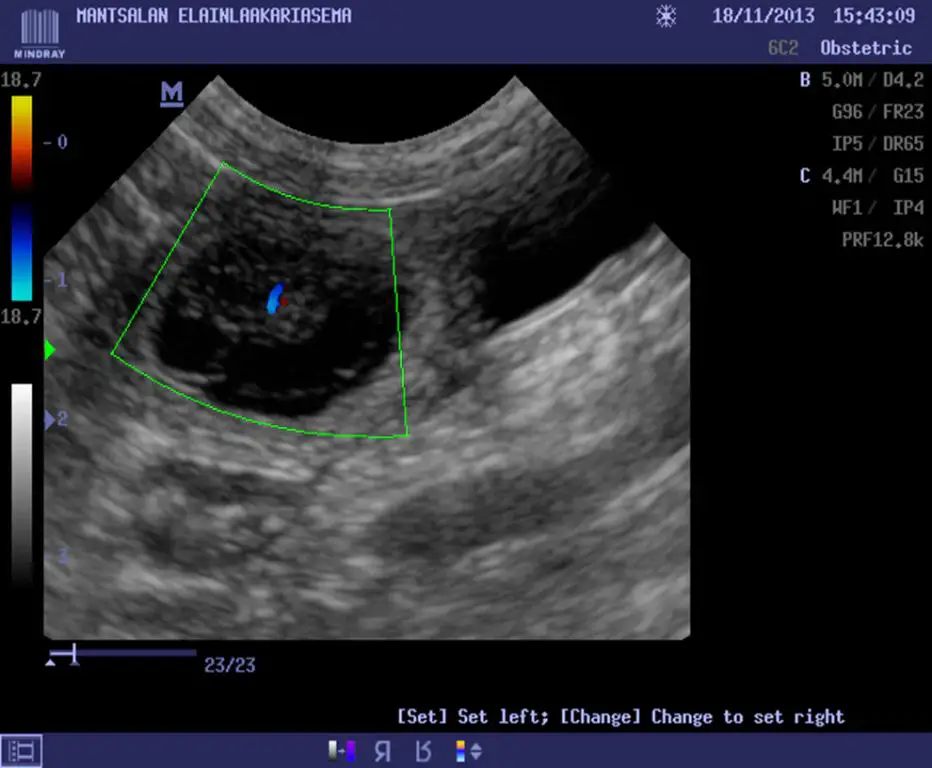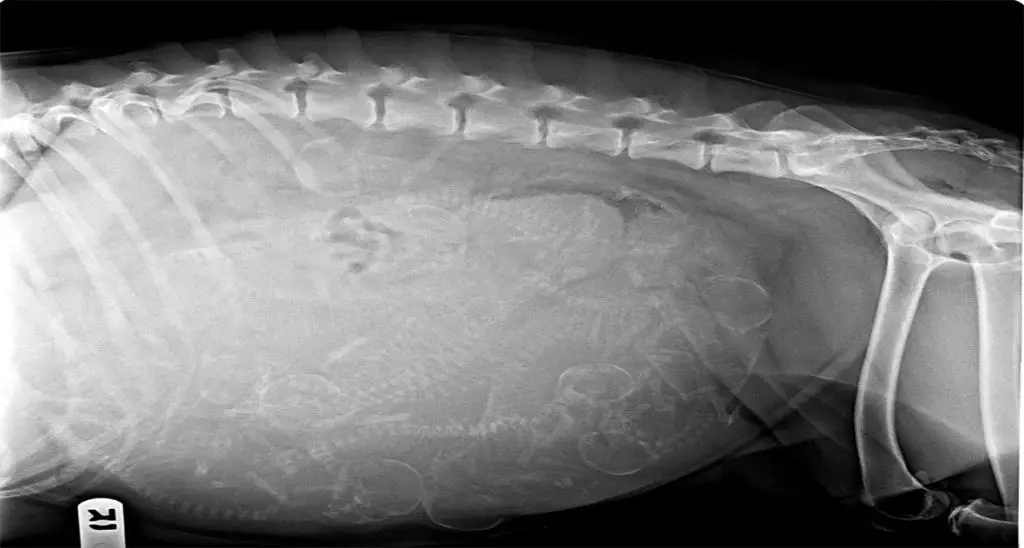Introduction
Detecting pregnancy early is important for providing proper care to expecting dog moms. The normal gestation period for dogs is around 63 days. Getting an ultrasound around 40 days into the pregnancy allows for visual confirmation that puppies are on the way. At this stage, the puppies will be more developed and recognizable in the ultrasound image. This gives owners a chance to prepare and make adjustments to care for mom and the coming puppies.
When Can You Ultrasound a Pregnant Dog?
Ultrasound is a useful tool for confirming pregnancy and monitoring fetal development in dogs. However, there are limitations on when an ultrasound will provide reliable results.
According to https://www.dvm360.com/view/performing-ultrasound-evaluate-pregnancy-proceedings, a dog’s gestation period is around 63 days. Typically, you can get clear ultrasound images starting from day 25 to 35 of pregnancy. The accuracy increases after this stage when the fetuses are more developed.
Before day 25, the fetus size and position can make it difficult to visualize them properly on ultrasound. The uterine wall also appears thickened in early pregnancy, obscuring the view. Waiting until at least day 25 allows for more definitive ultrasound results.
What to Expect at 40 Days Pregnant

By 40 days into a dog’s pregnancy, the puppies have developed significantly. An ultrasound at this stage will provide a lot of interesting information about the health and development of the litter.
One of the most exciting things visible on an ultrasound at 40 days is the puppies’ skeletal structure. The fetal skeletons become visible starting around day 35, and by day 40 they are clearly defined on an ultrasound image. This allows you to get an accurate count of how many puppies are expected.
You will also be able to see the puppies’ beating hearts on the ultrasound by 40 days. Detecting heartbeats confirms the fetuses are alive and developing normally.
In addition, the puppies will now be large and active enough that their movements can sometimes be observed during the ultrasound. Seeing the puppies wiggle and kick is a reassuring sign of health.
Overall, an ultrasound at 40 days pregnant provides a wealth of information about litter size, puppy viability, and normal physical development. It’s an ideal time to get imaging done. (Source)
Preparing for the Ultrasound
Proper preparation is crucial for obtaining quality ultrasound images and accurately determining if a dog is pregnant. The dog’s abdomen should be clipped and shaved to remove any hair that can interfere with the ultrasound waves. Focus on shaving the area from the chest to hips and underside of the abdomen. Use a sensitive skin clipper blade and conduct gentle, careful shaving to avoid irritation.
After shaving, apply a generous amount of conductive ultrasound gel to the dog’s abdomen. The gel allows the ultrasound transducer to glide smoothly across the skin and optimize acoustic coupling. Select an aqueous, non-staining ultrasound gel that won’t harm the dog’s skin. Spread the gel to coat the entire shaved area.
During the ultrasound, maintain a relaxed, calm environment to keep the dog settled. The person performing the ultrasound should use slow, gentle movements and minimal pressure with the transducer. Sudden movements or excess pressure can startle the dog and make images blurry. Patience is key to coax the best cooperation from the mother dog.
Proper preparation with clipping, conductive gel, and a soothing technique sets the stage for an informative ultrasound to determine pregnancy status at 40 days.
Interpreting the Ultrasound Results
At around 40 days into a dog’s pregnancy, an ultrasound can provide important information about the developing puppies. The main things the vet will look for are:
Detecting heartbeats. By 40 days, the puppies’ heartbeats should be visible on ultrasound. This confirms they are alive and developing normally. Puppies with no detectable heartbeat may indicate fetal death or resorption.
Checking spinal development. The puppies’ spinal columns should be fully formed by day 40. Issues like spina bifida can sometimes be detected at this stage.
Estimating litter size. Ultrasound allows the vet to get an estimate of how many puppies are present by identifying them individually. However, the full litter count can’t be confirmed until delivery.
Looking at fetal movement. By 40 days, the fetuses should be moving spontaneously during the ultrasound. Lack of movement may signal problems.
Assessing fetal size. The vet can take measurements of the puppies’ skulls and bodies to estimate their developmental progress and growth. Smaller puppies may need extra monitoring.

Overall, the ultrasound at 40 days into a dog’s pregnancy provides the vet and owner important feedback on how the puppies are progressing so any potential issues can be identified early.
Ultrasound Limitations
Though ultrasound is the most common method for confirming dog pregnancy and estimating litter size, it does have some limitations. Ultrasounds can be very accurate for detecting pregnancy at around 25 days along, but estimating the litter size can be more difficult, especially early on in the pregnancy.
One study found that ultrasound had 98.7% sensitivity for detecting pregnancy but could underestimate litter size by up to 33% in some cases [1]. This is because it’s easy to miss some puppies on ultrasound, especially if they are positioned behind other puppies. The positioning and activity level of the puppies makes it hard to get an accurate count.
Additionally, ultrasound accuracy depends heavily on the skill and experience of the veterinarian performing it. Less experienced vets may struggle to interpret the images correctly.
For these reasons, follow up ultrasounds and x-rays are recommended later in pregnancy to confirm puppy count as the due date gets closer. While ultrasound is a useful tool, it’s not 100% accurate on its own and should be paired with other methods.
Supplementing Ultrasound with X-Rays
While ultrasound is useful for detecting pregnancy early on, x-rays become more reliable later in pregnancy for confirming puppy count. According to Conyers Animal Hospital, “X-rays are probably the most effective way to determine if your dog is pregnant. Our Veterinarians are able to x-ray your dog 52 days after breeding.” This is because the puppy skeletons will be visible on x-ray at this stage.
B.C. Fulton explains that “Radiology is more accurate for counting foetal numbers in late-stage (after @ day 55).” So while ultrasound can detect pregnancy in the first few weeks, after day 52, x-rays give a clearer picture of how many puppies to expect.
Weldrick Animal Hospital agrees, stating “The most reliable way of detecting and monitoring pregnancy is an abdominal ultrasound. Developing embryos can be detected as early as three weeks post-breeding by abdominal ultrasound. Radiographs (x-rays) are useful for counting puppies, determining size of puppies and monitoring the skeleton.”
Therefore, supplementing early ultrasound with x-rays later in pregnancy can provide important information to owners preparing for whelping.
Estimating Puppy Delivery Date

One of the most common methods for estimating a dog’s delivery date is to count 58-72 days from ovulation or the first mating. This range accounts for the normal variation in canine gestation periods. According to the Canine Pregnancy Calculator, the average length of pregnancy in dogs is 63 days from ovulation.
To estimate the delivery date:
- Note the date of mating or ovulation.
- Add 58 days for the earliest possible delivery date.
- Add 63 days for the estimated due date.
- Add 72 days for the latest possible delivery date.
This 58-72 day timeline provides a delivery date range so owners can prepare and watch for signs of impending labor. Of course, every dog is different, so the actual birth may occur a few days earlier or later than estimated. An ultrasound around Day 40 can help confirm puppy count and narrow down the due date range.
Preparing for Puppies
As the delivery date approaches, it is important to prepare the whelping environment and supplies ahead of time. Some key things to prepare include:

- Whelping box – You’ll need a box or pen large enough for the mother to lie down and give birth comfortably. Line it with clean bedding. https://www.akc.org/expert-advice/dog-breeding/dog-pregnancy-care-prep/
- Supplies – Gather clean towels, unwaxed dental floss, scissors, bulb syringe, heating pad, thermometer, and emergency vet phone numbers. https://www.pdsa.org.uk/pet-help-and-advice/pet-health-hub/other-veterinary-advice/whelping-a-guide-to-your-dog-giving-birth
- Vet exams – Schedule a vet visit 1-2 weeks before delivery to confirm pregnancy and monitor health. Discuss emergency plans. https://www.petmd.com/dog/conditions/reproductive/dog-pregnancy-birth-and-puppy-care-complete-guide
Proper preparation will help ensure the whelping process goes smoothly and Mom and puppies remain healthy.
Conclusion
Ultrasounds are an important tool for monitoring your dog’s pregnancy and estimating delivery dates. By 40 days pregnant, the puppies will begin to take shape and a skilled veterinarian can count them on ultrasound. However, ultrasounds have limitations in detecting exact puppy counts and identifying abnormalities. Supplementing with x-rays provides a more complete picture. Knowing what to expect at the 40 day mark can help you feel prepared and make plans for the exciting arrival of your puppies.
Tracking your dog’s pregnancy week by week provides insight into her changing needs as well as the development of the puppies. An ultrasound gives you a glimpse into the womb so you know how many puppies to anticipate. This allows you to properly stock supplies and prepare yourself for those first few weeks of round-the-clock puppy care. While the 40 day ultrasound is not definitive, it creates a helpful estimate.
Most of all, ultrasounds during pregnancy offer peace of mind that the puppies are growing on track. By monitoring your dog closely, you can help ensure the pregnancy progresses smoothly and results in the safe delivery of happy, healthy puppies. Paying close attention now makes a big difference as your beloved pet prepares to become a mother.